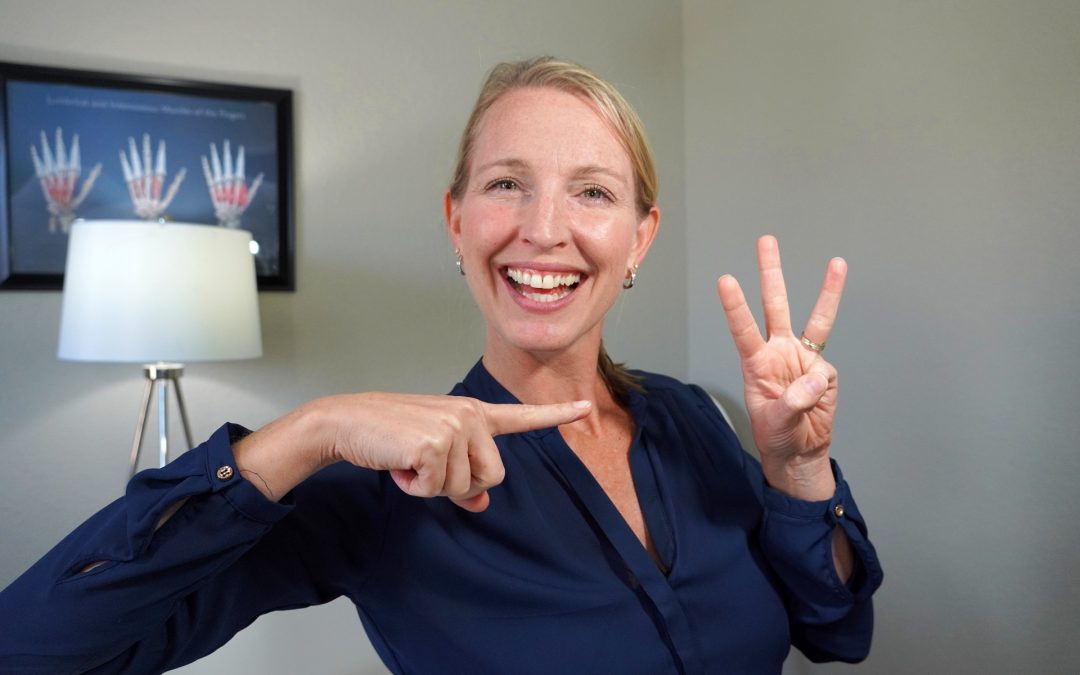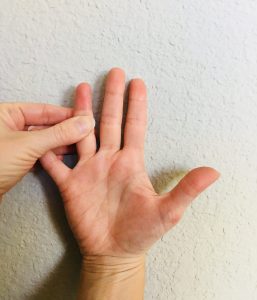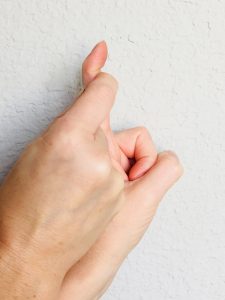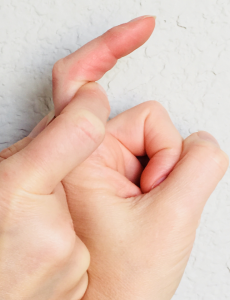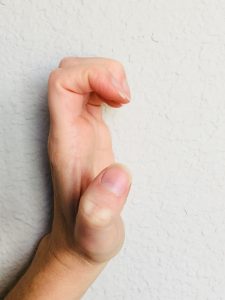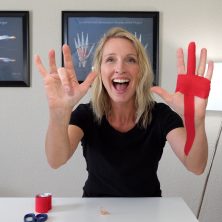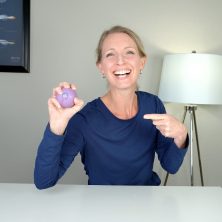Are you looking for finger stiffness exercises that will ease your joint achiness fast?
In this blog post, I’m going to share with you my Top 3 finger stiffness exercises.
These are perfect if you want simple, no nonsense exercises that can be done in just a few minutes. And best of all, no equipment is required.
The only thing you need to do is use your other hand to help, if possible.
Keep in mind, some of you may find these finger stiffness exercises fairly easy. But they will still leave your fingers feeling good!
Who are these exercises for?
You’ll want to try these if you are experiencing:
- Stiffness of one finger due to arthritis in the small joints of your finger.
- Whole hand stiffness due to arthritis.
- Loss of range of motion and stiffness as a result of a finger or hand injury.
As a quick disclaimer, do make sure if you recently had an injury or surgery, that you are completely cleared to do these exercises by your doctor.
Work the small finger joints first.
When it comes to getting your finger flexibility back, I have found most people want to jump right into making a full fist.
But what you should do is back up just a little bit.
Actually what you really want to do is work on improving the mobility of each of your small finger joints first. Then try to flex your fingers into a fist.
Small motions will lead to big gains.
First, by moving the small joints of the fingers, this helps you create a more natural pattern of finger flexion. When you curl your fingers, you actually curl more with the fingertips, followed by the middle joint, and finally your larger knuckles will bend down.
However, when you have finger stiffness, most of the time you’ll have a tendency to do the opposite. You will likely bend at the knuckles first then try to curl your small finger joints.
That is an abnormal fist pattern that develops when finger stiffness prevents you from moving in your full range of motion.
Luckily, these exercises are going to show you how to work on that more natural pattern of finger flexion. This will not only feel more comfortable for you, but you will see faster results.
Oh and did I mention, you’ll notice decreased pain and finger swelling too.
Let’s get started!
Finger Stiffness Exercise Number 1: DIP Blocking
With this first exercise, you want to start by moving the small joint of the tip of the finger. This is your DIP joint, also known as your distal interphalangeal joint.
Your DIP joint is what helps you get that nice, tight grip you are longing for. You want your DIP joint to be flexible if you want to be able to make a full fist.
Not to mention, DIP joint flexion allows you to hold on to small objects such as pills, coins, and a variety of other small objects.
To do this exercise you want to use your other hand to block the DIP crease of whichever finger is stiff.
If your whole hand is stiff, then you will want to do this exercise to each DIP joint of each finger.
Make sure you place your other hand right below the DIP crease. You do not want to place your hand too high or you will prevent your fingertip from moving through full range of motion.
Another important tip is to make sure you are keeping your middle joint straight. This is known as your PIP joint, or proximal interphalangeal joint.
You can apply a little bit of pressure to prevent the PIP joint from wanting to flex. In the photo below, I have my index finger right below my DIP joint. Then I have my thumb blocking my PIP joint. You will do the same, depending on the finger, or fingers, you are working on.
Next, you want to actively flex and extend your fingertip. By doing this, you are isolating your FDP tendon, also known as the Flexor Digitorum Profundus. The FDP is the only tendon that bends the tip of the finger.
Perform 10-15 repetitions, and hold each repetition for 2-3 seconds.
A common compensation for these exercises is wiggling or moving too fast.
In order for these finger stiffness exercises to be effective you want good quality movements. By holding your DIP flexion a couple of seconds, you can get a good stretch to the DIP joint and a good contraction of your FDP tendon.
Next, you can use this same technique to your other stiff fingers too. All your fingers would benefit from 10-15 repetitions, a couple of times a day as long as your stiffness persists.
Keep in mind, the tendons that bend your fingers are sharing the same muscle belly in the forearm. So as you work on flexing one finger, you will notice the finger next to it bending.
That is normal, so let your other fingers move too!
Finger Stiffness Exercise Number 2: PIP Blocking
This exercise will focus on flexing the PIP joint, or middle joint of the finger. For some of you, you may not be able to bend your PIP without bending your DIP. That is okay.
However, if you can isolate just your PIP joint without flexing your DIP then try that first.
Just like in exercise 2, use your other hand to block right below the PIP joint crease. Then actively bend and straighten your PIP joint. Your FDS, or Flexor Digitorum Superficialis tendon, is helping you complete this movement.
Along with actively gliding your tendons, in this finger exercise, you are also reducing tightness of your PIP joint capsule and ligaments.
Repeat this 10-15 repetitions, and hold each repetition for 2-3 seconds. Perform these a couple of times a day as long as your stiffness persists.
By all means, do these PIP blocking exercises to all your fingers to beat joint stiffness and ultimately increase your overall hand function.
Quick hand nerd side note…
Some of you may notice when you flex your small finger you cannot bend your PIP joint without bending your DIP joint.
The reason for this is because some of you may only have one tendon (FDP) to your small finger. Some studies suggest around 50% of the population only has an FDP to their small finger. If you cannot bend your PIP without bending your DIP then you may be one of those people.
And if so, I’m in the one tendon pinky finger club too!
Finger Stiffness Exercise Number 3: Hook Fist
Finally, we will wrap up with our last finger stiffness exercise. The hook fist. This one is going to combine exercise 1 and 2. And all your fingers will be moving simultaneously together so you don’t need to do this one separately to each finger.
Remember when you have stiff fingers and can’t make a fist, most of the time, you may be trying to bend at the knuckles first. Then, unsuccessfully try to bend the small joints.
Like I said above, this is an abnormal fist pattern. This exercise will get your fingers moving more normally by activating your long finger flexors.
First, you want to use your other hand to block your MCP joints, also known as your metacarpal phalangeal joints. To do this place the fingers on your other hand between the finger web spaces.
You can position your hand a few different ways.
Your palm can be turned toward you with your other hand placed over your palm to block the knuckles. Or you can turn your palm toward you while placing your other hand on the back side of your hand, as shown.
Whichever way feels more comfortable for you!
Additionally, I find that by applying a little bit of pressure in between your fingers at the web spaces can help relieve joint achiness when doing this exercise.
Once you find a position that feels comfortable, you are ready to start bending only your DIP and PIP joints to make a hook fist, aka claw fist.
Flex the joints down as far as you can. Then straighten as much as you can. Hold a couple of seconds as you flex and again as you straighten. Repeat these 10 times.
You may need to do these finger stiffness exercises 3 or 4 times a day.
Motion is lotion
Eventually what happens is the more you do these finger stiffness exercises the more your joints will loosen up. Plus the more your tendons will begin to glide and slide over your stiff joints.
It is important to repeat each exercise for 10-15 repetitions, holding 2-3 seconds, while performing them a couple of times a day. As long as your finger stiffness persists.
The good news is over time you may not have to do these exercises as often.
With this in mind, you may decrease them from 3 or 4 times a day, to 2-3 times a day, and eventually just one time a day to keep stiffness out of your finger joints.
Conclusion
By now your fingers should feel a little more flexible than they did before you started.
You may want to consider adding these top 3 finger stiffness exercises at least once a day to avoid finger achiness or stiffness from creeping back in. They shouldn’t take you more than 5 minutes a day.
If you found this helpful do share this post with family and friends that use their hands a lot.
Want more exercises and helpful tips for your stiff fingers?

